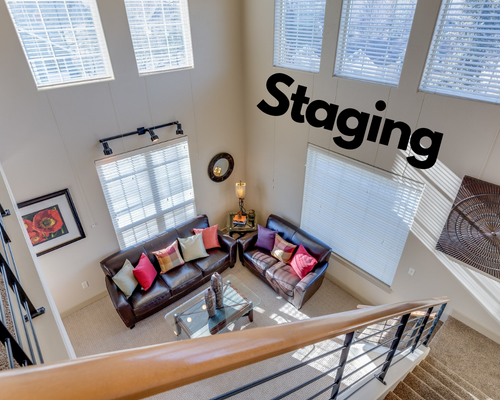
Staging involves preparing your home or “setting the stage”, to be seen in the best light by potential buyers. This involves highlighting its best features, but also providing the ability for the buyer to “see themselves” and their belongings in the home.
Staging is really a point in time that a home seller needs to make the commitment to begin the move out of the home. There are many ways to accomplish this without having to completely remove all of your belongings form the home, although to stage the home effectively it is typical to relocate up to 50%. This can be done through the use of a Pod, a temporary storage unit or other offsite location. The seller should avoid using desirable living space such as garages or spare bedrooms to stage these belongings as it will detract from the buyer’s sense of use of these rooms.
The objective of staging is to make a discernable and positive first impression of the home. The focus should highlight the living room, kitchen, bathrooms, bedrooms, and outdoor living spaces. These are areas that buyers will primarily be interested in. Your objective should be to present these rooms in an objective representation which is not too personal, very bright, very clean and “maintenance free”. The décor should be minimalist, and only use furnishings to outline the space of the room.
The National Association of Realtors state that 95% of staged homes sell in 11 days or less, which is 87% faster than non-staged homes. They also sell for an average of 17% more than non-staged homes.
While good staging is essential to produce interest when buyer’s visit your home, 43 percent of buyers first step they take in the home buying process is to look online at properties for sale. This means that the photographic representation of your home needs to be as accurate, if not more than seeing the home in person.
Here are some tip’s to make the best impression possible:
Curb Appeal – This refers to the first impression a buyer makes of your home when they arrive (or maybe even before). The front façade of the home needs to be cleared of any debris, personal effects like toys, bikes or basketball hoops, gardening tools, holiday decorations and other personalized décor. Excess parking should be eliminated in front of the home and limited in the provided parking space.
It is always a good idea to keep lawns cut and edged. Add some fresh mulch to any flower/planting beds and consider adding some live plants or flowers that frame the entranceway of the home. Adding a fresh, neutral color, coat of paint to the front door and or shutters can make the entrance very appealing.
Cleaning & Repairs – Cleanliness is a virtue, but it’s also essential to making a good first impression. Sometimes homeowners can overlook common areas throughout the house, but many times it will be the first thing a potential buyer will point out when walking in a room. This step is often times best performed by hiring a deep cleaning expert, but it’s still good to understand where to look! First place that is commonly missed is above your sight line. HVAC vents & returns, ceiling fans and ceiling corners can collect dust which is common. Going back to refocus on the rooms of most importance, like the kitchen, baths and master bedroom, it is important to focus on the flooring and countertop areas.
Any minor repairs that have been delayed need to be addressed. Make sure that all of the cabinet drawer and door pulls are present and match (replacements might be an easy upgrade). Any old faucets, especially any that leak need to be repaired or replaced. You should go through every room to make sure that every light fixture has a working bulb. Make sure that all light bulbs are the same for each room. i.e. do not mix blue LED bulbs & yellow incandescent ones in the same room.
Personalization – The second biggest impact that you can make in staging the interior of the home would be to declutter and de-personalize. This is especially relevant in the common areas of the home. A rule of thumb would be to remove every non-décor item possible from every kitchen and bathroom countertop.
All Realtors are sworn and legally bound to fairly represent our clients and their homes without regard to race, color, nationality, religion, sex, familial status or disability. However, all people have biases, and it is an unfortunate reality that these may have an impact on a buyer’s willingness to make an offer, or the kind of offer being made. Therefore, it is best to remove all personal items, family pictures, trophies, collectables, or any other item that would reflect your personality, demographic, political or religious affiliation.
Kids & Pets – One of the hardest things to stage for are our family and fur babies. We love them and they are a part of our lives, but their impact on a home can be a deal breaker. The best suggestion would be to at least isolate the areas/rooms for kids to enjoy, hopefully omitting most common areas.
Pets come with their own challenges. First, having an aggressive pet present during any interaction with the public should probably be avoided. Pet sitting services provide an excellent and entertaining opportunity to remove the pet for a short period of time.
Pet’s can also leave behind both odors and pet specific damage. If possible these situations need to be professionally mitigated prior to showing the home. Some people are allergic to the proximity of pet dander which can have an immediate impact on the buyer’s impression of the home, while it has no bearing on others. Having your HVAC system & carpets professionally cleaned can help eliminate any possible allergic situation.
Other Pro Tips –
Curtains – You will want to assure that the most amount of light possible in each room. However, the view of the next door neighbor’s wall may be a distraction. Gauze curtains can be a source to provide light while obscuring the actual view. Make sure that these match throughout the room for every window.
Closets –Limiting the amount stored in large closets will make them look like they have more space. Smaller utility closets can be filled without too much expectation.
Accessorize in 3’s – Vases, pictures, and virtually any type of décor item shows better in sets of three.
Deodorize – Human’s olfactory senses are one of the strongest subliminal drivers.
Photography –
As was stated above, 43 percent of buyers first step they take in the home buying process is to look online. That means the quality of photography that is taken of the home is essential toward making an impression strong enough for the buyer to take action. The variation of photography allows the user different perspectives into seeing the home in a way that is usually not possible even in person. We use professional photographers for all of our listings as well as employ a number of technologies to provide an insight for the buyer. The cost of most standard photo packages are usually around $500 per listing, but can escalate depending on the sophistication of the product offering.
Stills – some platforms can display over 100 photographs of a home. We usually stick to about 25 well selected photos that best represent the features of the home. All of our photographs are high definition, which basically varies the amount of light exposure within a room. This makes window light less harsh & dark corners & room entrances more light.
Floor Plans – offer perspective of the layout of the home. This provides the buyer information like room position and measurements, which can immediately assist in understanding the viability of the living space. All new homes come with floor plans, but it is an extremely rare, but fundamental marketing tool for resold homes.
Aerial photography, or drone shots – these are somewhat of a novelty in representing the home. There is a bit of value being able to see the roof condition, if you know what you are looking at. They also lend some perspective toward the surrounding neighbors and landmarks.
Virtual Tours – Many agents can provide a simple slide show of photographic stills. There are newer technologies that utilize a 360 degree camera. The associated software then stitches these photographs together in a linear chain that represents how you would travel from one room to the next. The software also facilitates being able to turn the view 360 degrees to see different angles of the room. These virtual tours are now commonly available on VR headset platforms.
This product is proving to be instrumental as a marketing tool to offer a glimpse into the home. However, the technology has yet to replace a typical buyer’s desire to physically view the home. It is still a standard practice for us to offer this feature with our listings.
Video – there are generally two types of video tour’s. The first is a montage of the still photo collection put to an easy listening sound track. These are very common as they are usually offered for free by the photographers or listing provider. However, they offer very little more than the still photos themselves.
There are actual videographers who will take a videos throughout the home and edit this into a virtual tour along with music soundtrack and voice-over. These are highly produced videos and the expense will usually outweigh the return on all but very expensive homes.
Digital Staging – is a new technological offering that digitally overlays, or “photo-shops” images of furnishings on top of images in vacant rooms. These too are highly produced and can be very expensive to achieve at the present time. All indicators are that this technology is becoming more approachable by the day.
Physical Staging – This involves strategically placing furnishings inside a vacant home. The staging would include furniture arrangement and decor throughout various rooms of the home. Physical staging can cost $1,000-$3,000 per home usually dependent on the size of the listing.
SEARCH THE MLS
5001 N Nebraska
Tampa, FL 33603


| Cookie | Duration | Description |
|---|---|---|
| cookielawinfo-checkbox-analytics | 11 months | This cookie is set by GDPR Cookie Consent plugin. The cookie is used to store the user consent for the cookies in the category "Analytics". |
| cookielawinfo-checkbox-functional | 11 months | The cookie is set by GDPR cookie consent to record the user consent for the cookies in the category "Functional". |
| cookielawinfo-checkbox-necessary | 11 months | This cookie is set by GDPR Cookie Consent plugin. The cookies is used to store the user consent for the cookies in the category "Necessary". |
| cookielawinfo-checkbox-others | 11 months | This cookie is set by GDPR Cookie Consent plugin. The cookie is used to store the user consent for the cookies in the category "Other. |
| cookielawinfo-checkbox-performance | 11 months | This cookie is set by GDPR Cookie Consent plugin. The cookie is used to store the user consent for the cookies in the category "Performance". |
| viewed_cookie_policy | 11 months | The cookie is set by the GDPR Cookie Consent plugin and is used to store whether or not user has consented to the use of cookies. It does not store any personal data. |